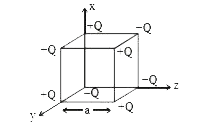A clock face has charges −q,−2q,,.....−12q fixed at the position of the corresponding numerals on the dial. The clock hands do not disturb the net field due to point charges. At what time does the hour hand point in the direction of the electric field at the centre of the dial.
The correct Answer is:C
Six vectors of equal magnitudes are as shown in figure. a. 
Now resultant of two vectors of equal magnitudes (=Esay) at 120∘ is also E and passing through their bisector line.
So, resultant of 1 and 5 is also E in the direction of 3. Similarly, resultant of 2 and 6 is also in the direction of 4.
Finally resultant of 2E in the direction of 3 and 2E in the direction of 4 passes through the bisector line of 3 and 4 (or 9.30)
Topper's Solved these Questions
- BOOK - DC PANDEYCHAPTER - ELECTROSTATICSEXERCISE - Level 1 Subjective15videos
ELECTROSTATICS
- BOOK - DC PANDEYCHAPTER - ELECTROSTATICSEXERCISE - SUBJECTIVE_TYPE6videos
ELECTROSTATICS
- BOOK - DC PANDEYCHAPTER - ELECTROSTATICSEXERCISE - Level 1 Assertion And Reason19videos
ELECTROSTATICS
- BOOK - DC PANDEYCHAPTER - ELECTROSTATIC POTENTIAL AND CAPACITORSEXERCISE - (C) Chapter exercises50videos
ELECTROSTATIC POTENTIAL AND CAPACITORS
- BOOK - DC PANDEYCHAPTER - GRAVITATIONEXERCISE - All Questions120videos
GRAVITATION
Similar Questions
A clock face has negative charges −q,−2q,−3q,....,−12(q) fixed at the position of the corresponding numerals on the dial. The clock hands do not disturb the net field due to point charges, At time x:30, the hour hand point in the same direction of electric field at the centre of the dial. Find x.
View SolutionCharges q,2q,3q and 4q are placed at the corners A,B,C and D of a square as shown in the following figure. The directon of electric field at the centre of the square is along
 View Solution
View Solution
Knowledge Check
- Question 1 - Select One
Two charges 4q and q are placed 30 cm. apart. At what point the value of electric field will be zero
A10 cm away from q and between the chargesB20 cm away from q and between the chargesC10 cm away from q and outside the line joining the chargesD10 cm away from 4q and outside the line joining them - Question 2 - Select One
Two point charges +4q and +q are placed 30cm apart. At what point on the line joining them is the electric field zero
A15 cm from charge qB20 cm from charge 4 qC7.5 cm from charge qD5cm from charge q - Question 3 - Select One
A cube of side 'a' has point charges +Q located at each of its vertices except at the origin where the charge is -Q. The electric field at the centre of cube is :
 A−Q3√3πε0a2(ˆx+ˆy+ˆz)B−2Q3√3πε0a2(ˆx+ˆy+ˆz)C2Q3√3πε0a2(ˆx+ˆy+ˆz)DQ3√3πε0a2(ˆx+ˆy+ˆz)
A−Q3√3πε0a2(ˆx+ˆy+ˆz)B−2Q3√3πε0a2(ˆx+ˆy+ˆz)C2Q3√3πε0a2(ˆx+ˆy+ˆz)DQ3√3πε0a2(ˆx+ˆy+ˆz)
If a charge q is placed at each vertex of a regular polygon, the net electric field at its centre is zero. Show it.
View SolutionA point charge q is placed at the origin . How does the electric field due to the charge very with distance r from the origin ?
View Solution" Electric field intensity due to a point charge " "q" ' at a distance 'r' from it is "
View SolutionTwo charges 4q and q are placed 30 cm. apart. At what point the value of electric field will be zero
View SolutionFive point charge (+q each) are placed at the five vertices of a regular hexagon of side 2a.what is the magnitude of the net electric field at the centre of the hexazon?
View Solution

